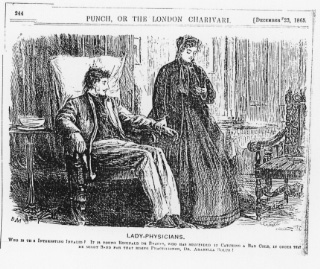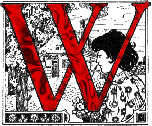
Punch,14 (December 23, 1865):244

 hen women left the domestic sphere, there were few occupations open to take them. Many women tended to become, especially after the expansion of primary and secondary schools in the 1860's. Women were willing to work for lower wages than men, and the teaching profession did not challenge traditional stereotypes. The medical field also seemed, at least on the surface, appropriate for women. It involved nurturing and compassion and was not particularly unfeminine. Women were only able to apply to medical schools starting in the late nineteenth century. Early female doctors, like Harriot Hunt, hoped that medicine would be the breaking ground for the rising sex. However expectations exceeded the actual outcome. By 1882 only 26 women were entered on England's medical register. In 1867, a contributor to The Lancet , a Victorian medical journal, wrote that, ' any woman who is logical, philosophical, scientific departs from the normal woman in her physical as well as her mental characteristics.' The belief in women's physical weakness, lack of intelligence and emotional instability made progress in this area difficult.
When George Du Maurier's Lady-Physicians appeared in Punch, women could receive a Certificate of Proficiency in medicine but could not obtain a degree. Therefore the woman in the picture could not truly be a lady physician. Perhaps this explains why her representation does not break the mold of the ideal woman (see my previous analysis). Even though she is standing, and technically in the position of power, she is looking down and away from the man she is treating. He does not treat her as an educated professional, but rather as the object of his gaze. This depiction is strikingly different from drawings later in the decade, where the "new woman" is more masculine. In Du Maurier's drawing, women's sexuality is still a major aspect of their presence and thus it is difficult to break the conception of women as passive, virtuous and beautiful. The physician, though it required education and certification, still encompased the traditional roles of women as nuturing and sustaining figures.
hen women left the domestic sphere, there were few occupations open to take them. Many women tended to become, especially after the expansion of primary and secondary schools in the 1860's. Women were willing to work for lower wages than men, and the teaching profession did not challenge traditional stereotypes. The medical field also seemed, at least on the surface, appropriate for women. It involved nurturing and compassion and was not particularly unfeminine. Women were only able to apply to medical schools starting in the late nineteenth century. Early female doctors, like Harriot Hunt, hoped that medicine would be the breaking ground for the rising sex. However expectations exceeded the actual outcome. By 1882 only 26 women were entered on England's medical register. In 1867, a contributor to The Lancet , a Victorian medical journal, wrote that, ' any woman who is logical, philosophical, scientific departs from the normal woman in her physical as well as her mental characteristics.' The belief in women's physical weakness, lack of intelligence and emotional instability made progress in this area difficult.
When George Du Maurier's Lady-Physicians appeared in Punch, women could receive a Certificate of Proficiency in medicine but could not obtain a degree. Therefore the woman in the picture could not truly be a lady physician. Perhaps this explains why her representation does not break the mold of the ideal woman (see my previous analysis). Even though she is standing, and technically in the position of power, she is looking down and away from the man she is treating. He does not treat her as an educated professional, but rather as the object of his gaze. This depiction is strikingly different from drawings later in the decade, where the "new woman" is more masculine. In Du Maurier's drawing, women's sexuality is still a major aspect of their presence and thus it is difficult to break the conception of women as passive, virtuous and beautiful. The physician, though it required education and certification, still encompased the traditional roles of women as nuturing and sustaining figures.[Victorian initial "W" by Harlan Wallach ©copyright 1994.]